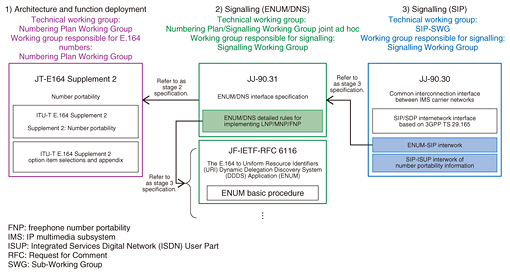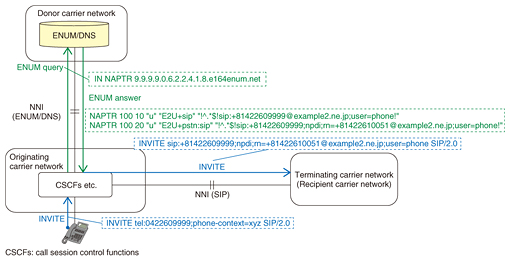 |
|||||||||||
|
|
|||||||||||
|
Global Standardization Activities Vol. 13, No. 12, pp. 77–82, Dec. 2015. https://doi.org/10.53829/ntr201512gls Standardization Efforts in IP Number Portability SpecificationsAbstractIn the near future, the inter-connections between communications carrier networks that use E.164 numbers are expected to migrate to Internet protocol (IP) technology rather than connecting them through the existing public switched telephone network (PSTN). For the migration, IP networks must support number portability functionalities in order to continue the current service, although such functionalities are currently supported only in the PSTN. We describe in this article the domestic number portability specification published in August 2015 as well as the NTT initiatives in this area. Keywords: number portability, IP interconnection, standardization 1. IntroductionNumber portability is a service that enables users to change their contract communications carrier without changing their telephone number [1]. Number portability for fixed telephone numbers is called local number portability (LNP), and that for mobile numbers is called mobile number portability (MNP). In Japan, the Ministry of Internal Affairs and Communications (MIC) allocates telephone numbers to communications carriers. The carrier to which the number is allocated can be identified based on the first five digits (except the first ‘0’) of a telephone number [2]. Conventionally, an originating carrier network forwards a call to a terminating carrier network based on the telephone number being called since the originating network can identify the terminating network from the called telephone number. However, with number portability, the originating carrier network cannot determine the terminating carrier network by inspecting the called telephone number; therefore, carrier networks need to obtain information in order to route a call to the terminating carrier network. 2. Solutions to number portabilityThe International Telecommunication Union, Telecommunication Standardization Sector (ITU-T) E.164 supplement 2 specifies four solutions to number portability: • All Call Query (ACQ) • Query on Release (QoR) • Call Dropback (CD) • Onward Routing (OR) The following database solutions for maintaining number portability data are also specified. • The data of all communications carriers are collected in a common database (common database solution). • Each communications carrier deploys a database for collecting the data of all communications carriers (individual database solution (all data collection)). • Each communications carrier deploys a database for collecting only its own data (individual database solution (own data collection)). 2.1 Method of implementing number portability in current telephone networks (PSTN)In a public switched telephone network (PSTN), the destination carrier network of a call destined to a number portability user is resolved using one of the following methods (see Fig. 1):
1) CD solution: an originating carrier network routes the call to a donor carrier network based on the telephone number, and the donor network provides the routing information to the originating network. Then the originating carrier network reroutes the call to the recipient carrier network. 2) OR solution: an originating carrier network routes the call to a donor carrier network based on the telephone number, and the donor network routes the call to the recipient carrier network using the routing information in the donor carrier network. In routing the call to the recipient carrier network, a network routing number (NRN) is used to identify the donor carrier network. Fixed carrier networks store NRNs in the subscriber circuit switches, and mobile carrier networks store them in the home subscriber server or home location register. Also, a connection request from the originating carrier network contains an indication that the originating carrier network requested the call to be routed by using either the CD or OR solution. The recipient carrier network determines the routing action based on the information. 2.2 Domestic standardization of IP number portabilityThe Mutual Understanding Meeting on PSTN Migration is a forum hosted by NTT EAST and NTT WEST that has been held regularly since 2010. In this meeting, representatives of domestic communications carriers discuss a variety of PSTN-migration-related requirements, including number portability. As a result of these meetings, it was agreed to adopt the ACQ solution as an Internet protocol (IP) number portability solution for the following reasons (Fig. 2):
• Because calls are not forwarded to the donor carrier network, codecs and services such as messaging are not affected by the services or capabilities supported by the donor carrier network. Calls can be connected to the recipient carrier network even when call control servers of the donor carrier networks are out of order. • Many countries have adopted this solution in their PSTNs. An individual database solution (own data collection) was selected for ease of deployment and security of data management. Based on this conclusion, a liaison statement that requests domestic standardization of IP number portability in order to implement the agreed-upon basic policies was created at the mutual understanding meeting and sent to the Telecommunication Technology Committee (TTC). For number portability standardization, it is necessary to standardize the system architecture and function deployment, as well as the signalling that is implementable on that architecture. To achieve this, the Number Portability Joint Ad Hoc Study Group was established as a joint ad hoc group of the Numbering Plan Working Group (responsible for E.164 numbers*) and the Signalling Working Group (responsible for signalling).
3. NTT initiatives for TTC standardizationOur group in NTT Network Service Systems Laboratories is working on some initiatives for standardizing the interface between communications carriers, which is called the network-to-network interface (NNI), to enable future IP interconnection between carriers (Fig. 3).
We studied signalling requirements related to number portability database queries, and to enable fixed and mobile carriers to be commonly used, we adopted the carrier E.164 number mapping (ENUM) applied in the Third Generation Partnership Project (3GPP) specifications and guidelines of the GSM (Global System for Mobile communications) Association (GSMA), and thoroughly took the initiative in making a draft of TTC standards related to domain name system (DNS) messages exchanged between ENUM servers and Session Initiation Protocol (SIP) servers as well as SIP server routing requirements using ENUM. The TTC conducted technical studies, and the specifications were published in August 2015 as JJ-90.31. The specification documents for number portability are indicated in Fig. 4.
Furthermore, with respect to the basic SIP/Session Description Protocol (SDP) NNI specifications, except those concerning number portability, we proposed the IP interconnection specification to TTC, and TTC published it in May 2015 as JJ-90.30 [3]. This specification conforms to 3GPP specifications. 4. Overview of number portability technical specificationsJJ-90.31 specifies basic signalling requirements for retrieving Uniform Resource Identifiers (URIs) corresponding to the telephone numbers over the NNI between different communications carrier networks. Protocols and procedures are also specified in JJ-90.31. Furthermore, JJ-90.31 conforms to ENUM/DNS Request for Comments (RFCs) (e.g., RFC 1034, RFC 1035, RFC 6116) and GSMA ENUM/DNS guidelines [4], with operating conditions related to migration from current telephone networks added. The ENUM is a mechanism by which an application can retrieve one or more applications corresponding to a telephone number in the URI format through the querying DNS using the telephone number as a search key. The source of an ENUM query uses a URI in Naming Authority Pointer (NAPTR) records in order to connect to the application. The TTC standard includes the following clarifications in regard to the corresponding international standards: • A priority value described in NAPTR records is specified, and supplementary rules on option parameters used in URIs are added. • Supplementary rules to ENUM/DNS procedures (iterative and recursive queries) are added. • Sequence and message examples are added. For example, as an ENUM/DNS procedure clarification, the answer condition for an absent number (a telephone number that is not in use) is clarified. For conformance to international standards and PSTN function deployment, JJ-90.31 specifies that ENUM/DNS answers a query by sending a NAPTR record(s) corresponding to the absent number as routing information to the donor carrier network, which is connected to the originating carrier network. Then the donor carrier network determines whether it is an absent number in the SIP layer. Taking into account the coexistence period of the PSTN and IP networks, we needed to consider the case in which the originating and donor carrier networks are IP-interconnected, but the originating and recipient carrier networks are interconnected via the PSTN. To address this coexistence period, JJ-90.31 specifies that multiple NAPTR records can be conveyed in the answer of an ENUM query to allow ENUM/DNS to include in the answer the URI information including the NRN, which is needed for the PSTN in connecting to the recipient carrier network (Fig. 5).
5. Future prospectsPreparation of TTC standard JJ-90.30, which specifies NNI basic SIP/SDP signalling requirements, and TTC standard JJ-90.31, which specifies the ENUM/DNS interface needed in SIP routing including number portability, have been completed, and the bilateral IP interconnection between communications carriers has shifted to the implementation phase towards commercial service. With the objective of realizing commercialization, we plan to work on achieving timely and continuous standardization in tandem with the discussion at the Mutual Understanding Meeting on PSTN Migration, while covering carrier demands. References
|
|||||||||||








